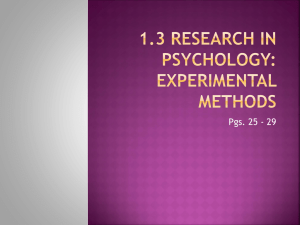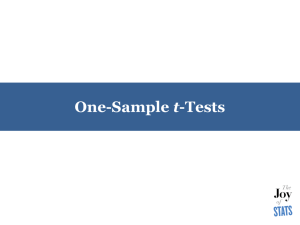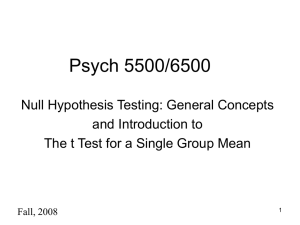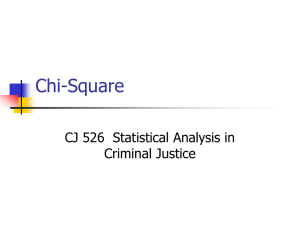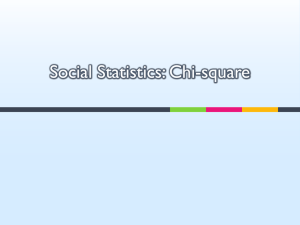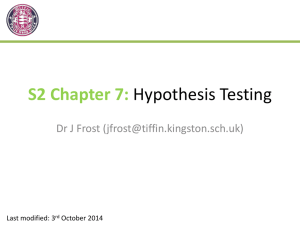Chi-Square Test
advertisement
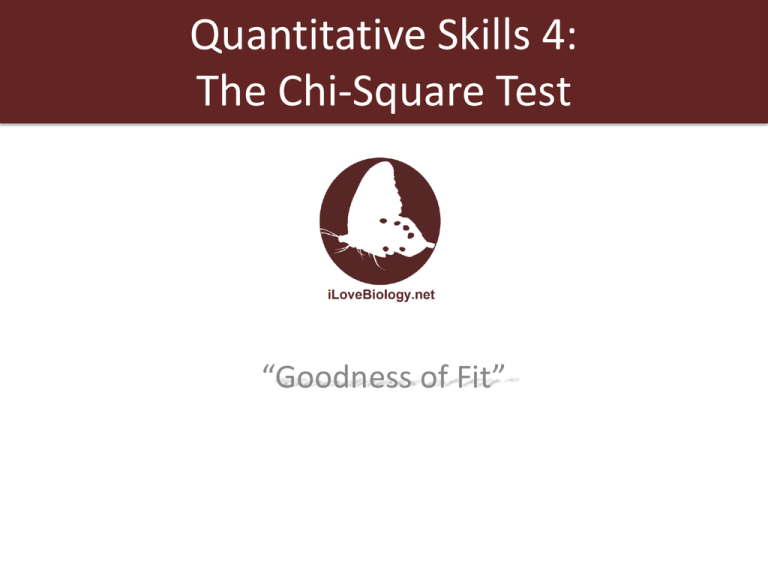
Quantitative Skills 4: The Chi-Square Test “Goodness of Fit” The Chi-Square (X2) Test is used to examine the difference between an actual sample and a hypothetical sample that would be expected due to chance. Probably due to chance Possibly due to chance Probably not due to chance Using Chi-Square, it is possible to discern whether experimental results are valid, or whether they are probably due to chance alone. The Chi-Square test compares two rival hypotheses (the null hypothesis and an alternative hypothesis) to see which hypothesis is best supported by the data. Establishing a null hypothesis (H0) and an alternative hypothesis (HA) • A null hypothesis states that there is no relationship between two variables. • The finding probably occurred by chance. • An alternative hypothesis states that there is a relationship between two variables. • The finding probably did not occur by chance. Example : “I think my cheese will mold if I leave it out on the counter too long.” Example null hypothesis (H0): If cheese is kept at room temperature for a week, then it will have the same amount of mold on it as the same amount of cheese kept in a refrigerator for a week. Example alternative hypothesis (HA): If cheese is kept at room temperature for a week, then it will have more mold on it than the same amount of cheese kept in a refrigerator for a week. The goal of the Chi-Square Test is to either accept or reject the null hypothesis. • If the null hypothesis is accepted, then there probably is no relationship between the two variables and the experimental results were probably due to chance alone. • If the null hypothesis is rejected, then there probably is a relationship between the two variables, and the experimental results are probably not due to chance. Observed and Expected Results • Observed results are what you actually observed in your experiment. • Expected results are a theoretical prediction of what the data would look like if the experimental results are due only to chance. How do you get expected results? • If you are working with a genetics problem, then use the Punnett square ratio as your expected result. • If you are working with a another type of problem, use probability. P(green) = .75 P(heads) = .5 Obtaining the X2 value: Example: We flip a coin 200 times to determine if the coin is fair. H0: There is no statistically significant difference between our coin flips and what we would expect by chance. (The coin is fair.) HA: There is a statistically significant difference between our coin flips and what we would expect by chance. (The coin is not fair.) The Chi-Square equation: 2 X = Ʃ (o – e)2 e 2 X = X2 = Ʃ (sum of all) (o – e)2 e (observed – expected )2 expected Example: We flip a coin 200 times to determine if a coin is fair. Setting up this kind of table is a VERY good idea! Observed Expected (o – e) (o – e)2 (o – e)2 e Heads 108 100 8 64 .64 Tails 92 100 -8 64 .64 classes X2 1.28 Critical Value Table Now you need to look up your X 2 value in a critical value table to see if it is over a certain critical value. Typically, in biology we use the p = 0.05 confidence interval. • The p-value is a predetermined choice of how certain we are. The smaller the p-value, the more confidence we can claim. p = 0.05 means that we can claim 95% confidence. Calculating Degrees of Freedom Degrees of Freedom = # classes -1 • In our example experiment, the classes were heads and tails (2 classes). • Degrees of Freedom in our experiment would be: DF = 2 - 1 = 1 Accept or Reject the Null Hypothesis • If the X 2 value is less than the critical value, accept the null hypothesis. (The difference is not statistically significant.) • If the X 2 value is greater than or equal to the critical value, reject the null hypothesis. (The difference is statistically significant.) In our example, the X 2 value we calculated was 1.28, which is less than the critical value of 3.84. Therefore: • We accept our null hypothesis. • We reject our alternative hypothesis . • We determine that our coin is fair.






